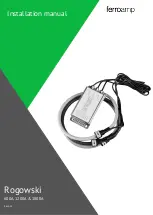
®
Due to continuous research, product improvements and enhancements,
Badger Meter reserves the right to change product or system specifications
without notice, except to the extent an outstanding bid obligation exists.
Copyright © Badger Meter, Inc. 2006. All rights reserved.
Please see our website at
www.badgermeter.com
for specific contacts.
BadgerMeter,Inc.
P.O. Box 245036, Milwaukee, WI 53224-9536
(800) 876-3837 / Fax: (888) 371-5982
www.badgermeter.com
ORION
®
is a registered trademark of Badger Meter, Inc.
TORX
®
is a registered trademark of Camcar, Division of Textron, Inc.
All other trademarks are trademarks of their respective owners.
Figure 3
Place the two plastic cable ties and tighten securely for strain
relief. Remove excess cable tie with the cutting device.
For remote installations, the connection is complete.
For pit installations, place all three connected wires with gel caps
into the field splice tube provided in the installation kit. Make sure
that the wires with gel caps are inserted as far as possible into the
field splice tube. Close the field splice tube. The connection is
now complete.
Testing the Wire Connections
The connection of the encoder and ORION
®
Universal 1
transmitter can be tested using the ORION Data Collector. It is
recommended that all wiring connections be tested while on site.
To test, place the ORION Data Collector into the ORION Quick
Read function. See the Badger Meter installation Manual RAD-
IOM-01
for more information on the Quick Read function and how
to operate the ORION Data Collector.
Pit Mounting Installation
The ORION Universal 1 pit transmitter is shipped pre-programmed
with a factory potted cable that can be connected to any
compatible Sensus, Neptune, Hersey or AMCo encoder. Prior to
installing an ORION pit transmitter, it is important to determine
whether it should be installed in a pit with a metal or a non-metal lid.
To determine the type of pit ORION transmitter, look at the serial
number tag attached to the wire harness. At the end of the serial
number tag attached to the wire harness. At the end of the serial
number, either a ‘M’ for metal or a ‘N’ for non-metal will designate
the proper lid application for the transmitter.
After determining the proper application, the ORION Universal 1 pit
transmitter can be installed either through or beneath the lid. An
installation kit can be ordered for each transmitter for mounting
through or beneath a pit lid. Note that the ORION Universal 1
transmitter should not be mount through the lid in applications
where vehicle traffic and exposure to snow plow blades and other
equipment may damage the transmitter.
PIT ORION INSTALLATION
The Pit ORION Transmitter (see Figure 4) is shipped with a flying lead
ready for connection to an approved competitive encoder. Excess
wire should be coiled up inside the pit and cable tied to avoid any
damage.
ORION Pit transmitters can be mounted through or below the pit lid.
See figures 4 and 6 for details. For below the lid installations, a special
mounting bracket (Figure 5) is available. This mounting bracket is
designed for use with 3/8", 1/2" and 5/8" rebar or 1/2" schedule 40
PVC pipe.
To install, drive rebar or stake into the ground prior to attaching Pit
ORION Transmitter to avoid damage. Once in the ground, secure the
mounting bracket on the appropriate rebar or pipe using the enclosed
washer, wing nut and hex head bolt provided with the bracket. Thread
the bottom-locking nut onto the Pit ORION Transmitter. Insert the Pit
ORION Transmitter through the bracket and thread the antenna nut
to secure the ORION transmitter (see Figure 6). For best results
mount the Pit Transmitter approximately 1-2" below the under-
side of the lid.
NOTE: ORION radio transmitters perform best with a clear line of
site and performance will vary by installation and lid construction.
ORION pit transmitters can also be installed in composite and plastic
lids like Armourcast. An installation kit for installing an ORION pit
transmitter to the lid is available. To install an ORION transmitter to
a composite or plastic lid, thread the locking ring onto the top of the
Orion transmitter. Slide the transmitter into the mounting bracket.
Thread the locking ring so that the transmitter is held firmly in place.
Remote Installation
ORION Universal 1 remote transmitters can be installed in any
indoor meter setting, including basement and utility rooms or
outdoor installation (not including vault or meter pit installations that
are subject to flooding or submergence). When installing an
ORION remote transmitter in a basement application, install the
unit as high as possible to optimize performance. Do not install
ORION transmitters close to metal objects like furnaces, water
heaters and appliances, electric equipment or within foil insulation
in the rafters.
1.75"
DIAMETER
HOLE
Figure 4 - Identification - Pit ORION Transmitter
PIT LID
PIT ORION
BLACK
HOUSING
.49
3.33
ADE or RTR
REGISTER
METER PIT LID
1/2 SCHEDULE 40
Figure 6 - Identification - Pit ORION Beneath Lid Installation
3/8 REBAR
1/2 REBAR
5/8 REBAR
HEX HEAD BOLT CAN BE PLACED
IN ANY SLOT DEPENDING ON
TYPE OF SUPPORT USED
1/2 SCHEDULE 40
PVC PIPE
#6-32 WING NUT
P/N 63517-001
#6 WASHER
P/N 55262-007
#8-32 X 3/4
HEX HEAD BOLT
P/N 55030-031
SUPPORT BRACKET
P/N 63516-001
Figure 5 - Identification - Pit Mounting Bracket - Top View




















